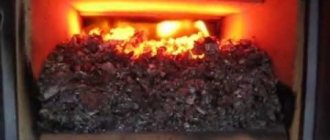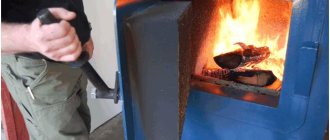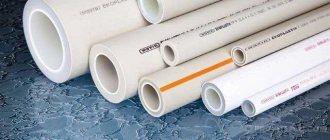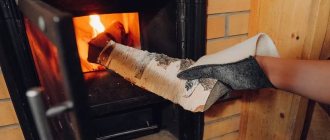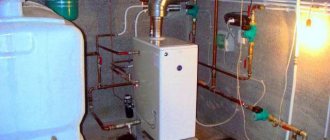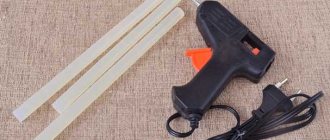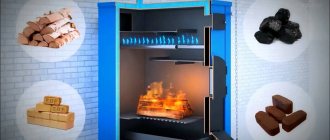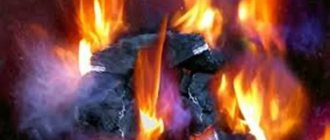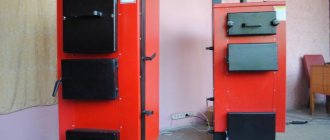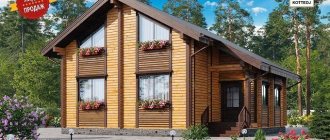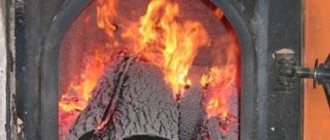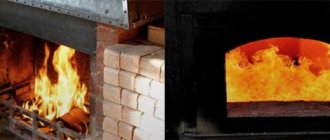Solid fuel boilers are a popular type of boiler equipment.
They are widely used for autonomous heating in facilities where it is not possible to use models running on natural gas.
Modern equipment of this class is capable of providing high-quality heating and at the same time is inexpensive, convenient and easy to operate.
For maximum heating efficiency, it is important to have an idea of how to properly heat a solid fuel boiler.
Features of the operation of modern solid fuel boilers
Solid fuel boilers of the modern generation are equipped with a pressurization system and an automatic control unit. Electronics controls the temperature of the coolant using a sensor installed in the heat exchanger.
Depending on the temperature conditions, the automation gives commands to turn on and off the blower, which supplies air to the combustion chamber and facilitates the effective removal of combustion products through the chimney. This regulates the intensity of the fuel combustion process depending on the temperature of the coolant.
Thus, the user takes the minimum necessary participation in the operation of the equipment. His concern about how to fire a TT boiler comes down to adding fuel at a certain frequency.
After this, the boiler switches to intensive combustion mode. As the temperature rises, the combustion intensity weakens, and when the temperature reaches its maximum, the boiler goes into smoldering mode. After the coolant temperature drops below the set value, the boost is turned on again.
Timely loading of fuel into the TT boiler is the main task of the user, which cannot be automated. The number and frequency of fillings is determined based on the boiler power and the required temperature conditions. If you miss the start date, the boiler will only be able to operate in smoldering mode for a limited time, after which it stops.
It is of great importance how to heat a solid fuel boiler.
Today the following types of fuel can be used for this purpose:
- firewood;
- coal;
- fuel briquettes;
- pellets.
To achieve maximum efficiency, you need to know how to effectively heat a solid fuel boiler with different types of fuel.
What to pay attention to
The operation of any heating device using coal, wood and other semi-finished fuel products is inextricably linked with the ventilation system. The performance characteristics of heating equipment and the technological parameters of the entire heating system in the house depend on the quality of ventilation and the condition of the chimney.
The hood must operate in accordance with established fire safety standards.
Important! An incorrectly made hood will create a risk of harmful combustion products entering living spaces. Insufficient traction will reduce the power of the device. Regular cleaning of the chimney will prevent soot from igniting, which can cause fire in house structures and create a fire hazard.
A properly made chimney and cleaning of the heating device will ensure long-term operation of the solid fuel boiler at optimal operating conditions. Frequently changing one type of fuel to another can cause unstable operation of the heating unit, failures in the hot water supply system and heat supply. Each unit should have one main fuel, while other types can be used for a short time, as needed.
Which fuel to choose
When deciding what is the best way to heat a solid fuel boiler, it is necessary to take into account the recommendations of the equipment manufacturer. Certain boiler models can be designed for specific fuels. However, many modern units are capable of operating on all of the listed types of fuel.
When choosing how to heat a long-burning solid fuel boiler conveniently and profitably, you need to take into account the burn rate of the fuel, which can vary greatly for different types. The frequency of necessary bookmarks and the ease of use of the unit depend on this.
Dry firewood is the fuel that burns out the fastest. Therefore, today fuel briquettes, which are made from dry sawdust, are often used for TT boilers. Such briquettes, which are also called “Eurowood”, burn out 1.5-2 times slower than ordinary dry firewood. Peat fuel briquettes are also produced.
However, they are characterized by high ash content, and therefore peat briquettes are used mainly for water-heating boilers with grate fireboxes. Coal burns the slowest. Some coal boilers, using high-quality anthracite and additionally equipped with a heat accumulator, are able to operate on one load for up to two days even in severe frost.
Pellets burn almost as long as coal, and at the same time provide a high level of efficiency. However, it is also the most expensive type of solid fuel for modern boilers. The main advantage of pellets is that they allow you to automate the operation of the boiler as much as possible, bringing it closer in convenience to the level of a gas unit.
However, they cannot be used in a conventional TT boiler - it must be equipped with a special burner and a combustion door of a special design.
Solid, liquid or gas?
Mini-boiler room diagram
Upon careful consideration (for which, unfortunately, there is no room here), in terms of the totality of qualities, natural gas and liquid fuels so far turn out to be the best. But it’s better not to try to make a stove for them yourself: without industrial equipment and well-established technology, even an experienced heating engineer will not undertake this. More precisely, he won’t take it on, knowing what’s what.
And there is a nuance: since this fuel gives off heat almost instantly, you can’t get by with just one stove. Combustion also requires a complex set of equipment. For an example, see Fig. scheme of a house mini-boiler room. This costs a lot, and it turns out to be economically (and environmentally) justified for households with a living area of more than 120-150 square meters. m.
Note: The efficiency of even a small gas or oil boiler with automation reaches 90% or more. Almost all losses in centralized boiler houses occur in pipelines.
A homemade stove can heat and supply hot water up to 60-100 square meters. m. residential. More - the complexity of the work and costs increase so much that it turns out to be cheaper and easier to install a double-circuit gas boiler. If, of course, there is a gas supply. In this case, you need to focus on the lowest of the indicated values; with bottled gas – to the highest level.
An exception is a pyrolysis (more precisely, gas generator) furnace using waste or dark heating oil. It is easy to do it yourself, subject to safety conditions. But the heated area is up to 40-60 square meters. m, heat extraction for hot water supply is difficult, and the installation of a full-flow water heating circuit is hardly possible. Those. scope of application: garage, cottage, small residential building, provided that the stove is in an extension.
Note: Pyrolysis oil is not a fuel for pyrolysis furnaces. It is a product of rapid (50-30 s) oxygen-free pyrolysis of wood waste at a temperature of about 600 degrees. Pyrolysis oil is quite heavily watered and has an acidic reaction, i.e. chemically aggressive components in its composition and contains up to 2% or more sulfur. It is burned in industrial boilers and furnaces using a special burner.
Firewood
The very first type of fuel, which continues to be the most popular. Firewood is the name given to fragments of wood of a certain size intended for combustion in various devices to produce thermal energy.
Most often they look like round parts of a whole trunk, but if the trees that serve as raw materials are thick, they are split into logs or logs in advance.
Firewood takes up the majority of the entire fuel market for privately owned boilers.
They deserve such popular love due to a number of advantages:
- Low cost. Russia is one of the countries rich in forest resources, so the price of firewood is low even in those regions where there is almost no natural forest or all of it has already been cut down. In settlements that are located near logging areas, the price is sometimes even lower due to minimal transportation costs and the opportunity to purchase fuel from the logger.
- Environmental friendliness. Unlike oil, coal and gas, wood is a renewable natural resource. After a certain time, new trees fill the old clearings. With a competent approach to forestry, it is possible to achieve no loss of forest areas.
- Ease of storage and preparation. The only thing you need to protect firewood from is moisture. To do this, it is enough to construct simple sheds and properly store them in a woodpile. Firewood is unable to ignite on its own without extraneous heat sources, so fire safety requirements are no different from those accepted for the household as a whole.
- Undemanding to the boiler design. Wood burns in any device. To burn them, a simple potbelly stove connected to a water tank is enough. More complex designs have high efficiency when the heat received from the firewood is used as efficiently as possible.
Perhaps this fuel has only two disadvantages, although they are quite significant:
- Due to the size and structure of firewood, it has to be prepared manually for loading into boilers. Therefore, sawing and splitting are necessary preliminary procedures for operating a wood-fired boiler. In this regard, automatic supply of firewood is difficult.
- The heat generation of natural wood is less than that of competitive raw materials that have undergone processing stages. It's all about the high level of natural humidity. Part of the heat is spent on evaporation of the liquid.
To purchase the dryest firewood possible, try to buy wood in late winter or early spring. They will sell you a fresh cut, where the juice has gone as deep as possible. During the summer and autumn, this firewood must be aged, so that by the next heating season it will dry out properly.
The calorific value of ideally dry wood is about 5 kWh/kg. However, in real conditions, such an indicator can only be obtained in special drying ovens - such firewood is much more expensive. The calorific value of most hardwoods is 4.2 – 4.3 kWh/kg.
Burning rate
In homemade stoves without complex automation, there is a clear correspondence: the faster the fuel burns, the lower the efficiency of the stove can be achieved and the more complex its design becomes. The reason is simple: without technological tricks inaccessible to the DIYer, it is difficult to capture a large amount of heat released at once and direct it into the room, or into a water heater, before it flies out into the chimney. Therefore, it only makes sense to make a homemade stove using slow-burning fuel - solid fuel, oil, oil sludge, etc. Or a slow-burning oven, where the combustion process is artificially slowed down.
In terms of combustion speed, coal stands out among solid fuels. It is very uneven as it burns. At first, when gasification occurs, the flame rages. And then, when pure carbon (amorphous carbon, coke) remains, slow smoldering begins. But making a stove with high efficiency in both combustion modes is not so easy.
Pellets
Pellet boilers are one of the most advanced solid fuel systems.
Pellets are small fuel granules that look like oblong cylinders 2–4 cm in length and about 7 mm in thickness. The raw materials for their production are waste from wood production: sawdust, wood chips, bark, as well as substandard wood, which is unsuitable for other purposes.
Pellets are produced by drying and pressing. When the mixture is subjected to pressure, the temperature inside it increases, lignin, a component of wood, is released, which firmly glues the particles together.
Torrefied fuel pellets are considered the most valuable fuel. They burn without oxygen, acquiring a dark color. Due to this, their heat capacity increases. In addition, they are not afraid of moisture and do not crumble over time.
Pellets have a number of advantages:
- Environmental friendliness and production using waste-free technology. Pellets are made not just from wood, but from production waste, which otherwise would go to a landfill or recycling incineration. The use of agricultural by-products, which are regarded as nothing more than garbage, makes pellets one of the most progressive types of solid biofuels.
- High combustion efficiency. Thanks to the production technology, pellets contain a small amount of moisture - only 8 - 12%, while naturally dried wood will still contain 25 - 30%, and fresh wood - 50% or more water. When burning fuel pellets, approximately twice the amount of
- Low ash content. Pellets are practically devoid of the main drawback of wood - they form a small amount of non-combustible residues, and the content of soot and soot in the smoke is reduced. The share of ash in the granules is only 3%, so boilers and chimneys when using them require less frequent cleaning.
- Good transportability. Due to relatively high mechanical strength, small size and high density, pellets are light and easy to transport. At production, they are packaged in various containers weighing up to one ton in big bags and can be delivered by any type of transport.
- Possibility of automated feeding. Due to the identical sizes of small granules, they can be fed into the boiler automatically, using special dispensers, Archimedes screws and other devices. This allows the solid fuel boiler to be endowed with a high degree of autonomy
Unfortunately, pellets have two significant disadvantages:
- The high cost, which arises from production costs: drying, pressing, firing. Therefore, compared to other wood fuels, the cost of pellets will always be higher.
- Enterprises that produce fuel pellets are not located in all areas. Buying pellets with delivery over long distances can completely negate their economic advantages.
Pellets are most widespread in European countries, where environmental fuel is in greatest demand. The possibility of useful recycling of waste, coupled with high energy efficiency, makes it the number one solid fuel, especially since there are almost no large forest areas allowed for felling in Europe.
Combustion temperature
This is a double-edged sword. One end - the higher the temperature, the easier it is to achieve complete combustion and high efficiency. On the other hand, again, it becomes more difficult to extract and direct where the heat is needed; due to the large temperature gradient, it tends to fly out into the chimney. Therefore, the design of the furnace becomes more complicated. In addition, high combustion temperatures require expensive heat-resistant materials.
In general, the lower the combustion temperature, the simpler and more efficient the stove is. Clumsy homemade designs that smolder at 600 degrees (slow burning stoves) can give an efficiency of more than 85%. It is difficult to achieve an efficiency of more than 75% from a wood/coal stove (800-900 degrees) in an amateur design, and it often turns out that the structure proudly presented in the video burned out or cracked before the end of the heating season.
Note: the maximum combustion temperature achievable in home-made designs is approximately 1100 degrees; These are pyrolysis and gas generator furnaces. Above - without special steels and refractories, it will only withstand a few test fireboxes.
Fuel briquettes
In its composition, this type of fuel is similar to pellets, but looks somewhat different: briquettes are larger and can be not only cylindrical, but also of any other regular shape. The starting raw materials are the same wood chips, sawdust, and shavings. Organic residues of plant crops grown in agriculture are also widely used.
Fuel briquettes have the same advantages and disadvantages as pellets. The main difference still comes from the size: briquettes are not suitable for automatic loading, so they are placed in the firebox manually. Products with an aesthetic appearance have gained popularity among owners of fireplaces and decorative stoves due to the almost complete absence of smoke during combustion.
The best of the best: fruity, birch and linden
This list is also supplemented by fruit trees: pear, apple tree. They emit a pleasant aroma and burn well, but it is difficult to make kindling with any hard logs. Birch and linden are considered the best for heating a stove. Birch has a low amount of moisture even in its raw form. Logs can be placed in the firebox without drying, they will still give off great heat and will smolder for a long time.
Linden is valued for its healing properties. If you heat the stove with linden wood, you will have a healing microclimate in your house or bathhouse. Linden burns slowly, with good heat transfer. Thus, the best varieties are hardwoods, and of these, birch and linden.
Coal
Among various types of solid fuel, coal has the greatest heat transfer, which makes it one of the most efficient energy carriers in heating boilers. The amount of heat released during the combustion of coal is twice as high as that for wood and is about 7.5 kWh/kg.
Thus, to maintain a certain temperature of the coolant in the circuit, coal will require significantly less than other types of solid fuel.
The most efficient in terms of heat production is anthracite. It contains a minimum of moisture and impurities. However, it is very expensive and burns quickly, giving a very high temperature, which is simply not needed in heating boilers.
The advantages of coal are due to its physical and chemical properties:
- High calorific value. With proper boiler design, a bucket of coal may well last for a day. The volume of fuel reserves purchased for the heating season is smaller, this is especially beneficial for small or densely built-up areas. Coal is not afraid of moisture. Although coal pits and sheds are built for storing coal, the inside of them does not need to be as dry as possible.
- When wet, coal retains its properties when it dries, since moisture does not penetrate inside.
- When burned, coal produces a very high temperature, which wood and its derivatives cannot produce. This allows the coolant in the circuit to be heated more efficiently with less fuel.
Unfortunately, coal is quite expensive. Even taking into account the fact that it produces more heat, there may not be any economic benefit from its use. Another thing is the location near famous coal basins. In these regions, coal is always cheaper and much easier to buy. In places of deposits, coal almost completely replaces firewood from use.
To prevent self-ignition, coal is stored on a non-combustible substrate and poured in layers. You should also be careful when firing a boiler with coking coal, which is sometimes purchased by owners of plots located near enrichment plants.
If used incorrectly, coke can produce such a high temperature that a steel and even cast iron furnace burns through, rendering the boiler inoperable.
Heat transfer table of all types
The energy efficiency of the listed fuel types differs. Even the same type of raw material, under changed production and storage conditions, will have different heat transfer rates. For comparison, average values are taken (see table).
| Type of fuel | Humidity, % | Calorie content, kcal/kg |
| Firewood | 20-25 | 2800-3400 |
| Coal | 12-18 | 6500-7000 |
| Brown coal | 14-22 | 3100-3600 |
| Peat | 28-30 | 2600-2800 |
| Pellets and briquettes | 6-10 | 4300-4700 |
Activity
Fuel activity is a conditional parameter. It characterizes the ability of a fuel to ignite and burn on its own.
Fuel that ignites from a spark is considered extremely active, and the combustion zone immediately spreads over its entire surface. Highly active fuel requires ignition with a small amount of even more active fuel or with the help of a wick, but then in the open air it ignites quickly and over the entire surface. Medium active requires ignition with more active fuel and without additional measures (scrub, stir) or pressurization in the open air it does not burn completely. Combustion of low-level fuel can only take place in special devices after ignition.
The activity of a fuel depends little on its calorific value, but much more on its state of aggregation, boiling point (for liquid fuel) and degree of grinding (dispersity) for solid fuel. For example, gasoline and ethyl alcohol are extremely active at room temperature. In diesel fuel at room temperature, the torch goes out, but, sprayed by a nozzle, it flares up in the open air at 90 degrees. Wood in the form of firewood is moderately active, in the form of dry shavings it is highly active, and in the form of sawdust it is very weakly active.
Note: according to the specifications, the flash point of summer diesel fuel is 62 degrees. But this is in a closed crucible.
How to properly heat a boiler with coal: instructions for ensuring long-term combustion
Before heating the boiler, you need to inspect it for damage and cracks, check the draft intensity, and also, by connecting it to the network, make sure that the electronic parts are working properly. Then it is recommended to clean the ash pan and combustion chamber, wipe them dry and then start heating the boiler with coal.
Experts advise heating boilers with fuel with lower efficiency, but more flammable, and then gradually adding coal in two batches:
- Place crumpled paper on the grill and place wood chips or brushwood on top.
- Close the firebox door and evenly set fire to the paper, etc., on all sides.
- Open the ash pan valve and wait until the fine fuel ignites.
- Sprinkle fine coal directly on top of the flame in a thin layer of 10–15 cm.
- After 15–30 minutes, add coarse coal to the upper border of the door.
- Leave the vent half open (only crack it if it’s smoking).
Now you can enjoy a comfortable temperature in the room by regularly adding fuel. Before refueling, the ash pan valve must be closed.
As you can see, it’s easy to heat a boiler, but in order for it to burn for a long time, not consume “extra” coal and be generally efficient, you will have to control its operation:
- stir up the burnt coal before a new load to prevent mass caking, and if a crust has already formed, break it with a poker;
- dilute insufficiently calorific (low-quality) fuel with small layers of wood to prevent layers of coal from coking together;
- organize thermal insulation of the house and install a thermostat in each room, which will avoid recycling the boiler and ultimately save up to 20–25% of coal;
- to ignite the paper, use the power of natural air circulation, even if the automation controls the inflation (this way the chimney will have time to warm up);
- completely clean the chimney and all internal components at least 2 times a year, otherwise after a few years the accumulation of soot will lead to a drop in efficiency by 25–30%.
Reference . To use resources even more economically, thrifty owners sift the ash waste on a 5–6 mm metal grid, and all large unburned pieces are sent back to the boiler along with a new portion of fresh coal. Thus, fuel consumption is reduced by an average of 10 - 15%.
Algorithm for calculating coal consumption
A modern type boiler can operate effectively on both hard coal and brown coal. But if you have a choice, it is better to choose high quality coal - anthracite. It is characterized by the highest thermal capacity and burns almost without a residue. However, the cost of anthracite is higher than other varieties. It is necessary to consider the price of fuel, delivery and its heat capacity, and choose the best option.
Which coal to choose for heating in a private home?
There are two ways to calculate coal consumption in a solid fuel boiler. The very first one is elementary, using a bucket. Coal is usually measured in tons, but it is unlikely that your boiler room will have scales to accurately weigh out the required dose for loading.
One bucket holds about 18 kg of coal.
Approximately, to heat a 200 m² home the following amount of angle will be required:
- In September-October, one bucket per day.
- From November to February - 10 buckets.
- In March-April there are about two buckets.
If you assume that there are 30 days in a month and add up all the values, you can find out the total number of buckets (780 buckets). In kilograms it turns out:
780 x 18 = 14040 kg
Thus, during the heating season, a coal boiler will consume a little more than 14 tons of coal to heat a 200 m² home.
The second method of calculating coal consumption in a solid fuel boiler is more scientific. Combustion of 200 g of coal will require about 1 kW of heat. For comfortable living during the heating season, approximately 50,000 kW of heat is required:
50000 x 0.2 = 10000 kg (10 tons)
